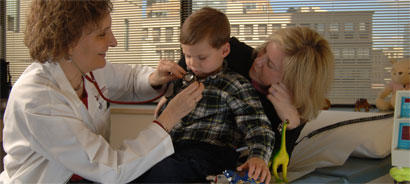Five Things Parents of Children With Cancer Should Know

Lisa Diller, MD, advises parents to remain positive if their child is diagnosed with cancer. Thanks to advances in research and treatment, the five-year survival rate in the U.S. is 84 percent for all childhood cancers combined, up from 61 percent in the mid-1970s.
What you should know about treating childhood cancer:
1. Although many signs and symptoms of cancer – fever, bruising, headaches – are normal in healthy children, pediatricians are extremely skilled at distinguishing the usual bumps and pains from concerning ones. By evaluating the character, duration, and severity of symptoms – as well as drawing on their own instincts – they know which symptoms require additional evaluation and promptly order the appropriate tests.
2. The need for specialized pediatric oncologists, pathologists, radiologists, and surgeons cannot be overstated, nor can the importance of seeking treatment at a center specializing in pediatrics. Not only do clinicians trained in pediatrics understand the needs of a child’s developing body, but cancer also presents differently in children and adults.
3. Physicians act quickly when a child is diagnosed with cancer. Using leukemia as an example, oncologists often receive a late afternoon call about a child seen in the office earlier in the day whose blood count results suggest leukemia. Typically, the oncologist sees the child in the emergency room the same day. Depending on the child’s condition, s/he will either be seen in an outpatient facility or admitted to a hospital and undergo several days of preliminary tests, which may include scans, biopsies, and blood work. A team of pediatric specialists, including an oncologist, surgeon, radiation oncologist, pathologist, and radiologist, will make a final diagnosis and design a treatment plan.
4. Primary care providers play a critical role before, during, and after treatment for cancer. During treatment, they often assist with outpatient care by monitoring blood counts and nutrition levels or providing nursing support. Pediatricians are also an integral part of a child’s return to normal life, starting with the two-year transition period after treatment during which the focus is on the risk of recurrence and side effects of therapy. Communication between the oncologist and the pediatrician is essential, especially concerning well-child care, growth, and immunizations. Eventually, the focus shifts from risk of recurrence to risk of late effects of chemotherapy and radiation.
5. Seek information from the websites of reliable cancer institutions, such as the National Cancer Institute (NCI) and the American Society of Clinical Oncology. The nearest medical facility that offers cancer treatment will not only have books and videos but will also have resource specialists to meet with parents and children.

 Translate
Translate